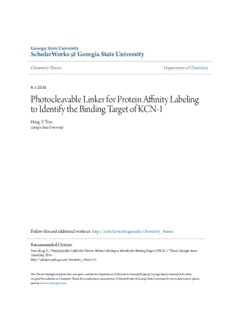
Photocleavable Linker for Protein Affinity Labeling to Identify the Binding Target of KCN-1 PDF
Preview Photocleavable Linker for Protein Affinity Labeling to Identify the Binding Target of KCN-1
GGeeoorrggiiaa SSttaattee UUnniivveerrssiittyy SScchhoollaarrWWoorrkkss @@ GGeeoorrggiiaa SSttaattee UUnniivveerrssiittyy Chemistry Theses Department of Chemistry Summer 8-1-2010 PPhhoottoocclleeaavvaabbllee LLiinnkkeerr ffoorr PPrrootteeiinn AAffiffinniittyy LLaabbeelliinngg ttoo IIddeennttiiffyy tthhee BBiinnddiinngg TTaarrggeett ooff KKCCNN--11 Hang T. Tran Georgia State University, [email protected] Follow this and additional works at: https://scholarworks.gsu.edu/chemistry_theses RReeccoommmmeennddeedd CCiittaattiioonn Tran, Hang T., "Photocleavable Linker for Protein Affinity Labeling to Identify the Binding Target of KCN-1." Thesis, Georgia State University, 2010. doi: https://doi.org/10.57709/1405588 This Thesis is brought to you for free and open access by the Department of Chemistry at ScholarWorks @ Georgia State University. It has been accepted for inclusion in Chemistry Theses by an authorized administrator of ScholarWorks @ Georgia State University. For more information, please contact [email protected]. PHOTOCLEAVABLE LINKER FOR PROTEIN AFFINITY LABELING TO IDENTIFY THE BINDING TARGET OF KCN-1 by HANG T. TRAN Under the Direction of Binghe Wang ABSTRACT KCN-1 is known to reduce tumor growth 6-fold in mice implanted with LN229 glioma cells. Although this inhibitor is effective, the mechanism of action for KCN-1 is not well understood. Based on preliminary studies, KCN-1 reduces tumor growth by disrupting the HIF-1 (hypoxia-induced factor-1) pathway. The binding target of KCN-1 needs to be investigated in order to develop KCN-1 or its analogs for therapeutic applications. In this research, a molecule was designed and synthesized for the identification of the binding target of KCN-1. Specifically, this molecule contains the inhibitor (KCN-1), a photocleavable linker, beads, and the affinity label (L-DOPA). When UV light shines on the linker, the trans-alkene isomerizes to cis-alkene and undergoes intramolecular ring-closing reaction, which helps cleave the immobilized bead from the linker. The immobilized bead is used to separate the binding fragment attached to the photocleavable linker from the solution after enzyme digestion. The affinity label (L-DOPA) reacts with a nucleophile from the binding target and creates a covalent bond. If the design is successful, this method is able to analyze the mass of the peptide sequence and determine the binding target of KCN-1. INDEX WORDS: Photocleavable linker, Affinity label, KCN-1, HIF-1 pathway PHOTOCLEAVABLE LINKER FOR PROTEIN AFFINITY LABELING TO IDENTIFY THE BINDING TARGET OF KCN-1 by HANG T. TRAN A Thesis Submitted by Partial Fulfillment of the Requirements for the Degree of Master of Science in the College of Arts and Sciences Georgia State University 2010 Copyright by Hang T. Tran 2010 PHOTOCLEAVABLE LINKER FOR PROTEIN AFFINITY LABELING TO IDENTIFY THE BINDING TARGET OF KCN-1 by HANG T. TRAN Committee Chair: Dr. Binghe Wang Committee: Dr. George Y. Zheng Dr. Stuart Allison Electronic Version Approved: Office of Graduate Studies College of Arts and Sciences Georgia State University iv ACKNOWLEDGEMENTS I would like to thank my research advisor Dr. Binghe Wang for his guidance and for showing me that success comes from dedication and perseverance. I would also like to thank the members of Dr. Wang’s Research Group for their help throughout my research career. I especially want to thank Weixuan Chen, my mentor, for his persistence and patience while guiding me through my research project. v TABLE OF CONTENTS ACKNOWLEDGEMENTS ...............................................................................................................iv LIST OF SCHEMES..........................................................................................................................vi LIST OF FIGURES ...........................................................................................................................vii CHAPTERS 1. INTRODUCTION 1.1 Hypoxia ..........................................................................................................1 1.2 HIF-1 Pathway ...............................................................................................1 1.3 KCN-1 Inhibitor .............................................................................................3 1.4 Affinity Labeling ...........................................................................................4 1.5 Purpose of the Study ......................................................................................6 2. DISCUSSION/RESULTS 2.1 Synthesis of Compound 11 ............................................................................10 2.2 Synthesis of KCN-1 amine 12d .....................................................................12 2.3 Approaches to Compound 13 .........................................................................13 3. CONCLUSIONS .......................................................................................................16 4. EXPERIMENT 4.1 General Methods ............................................................................................17 4.2 Photocleavable Linker ...................................................................................17 4.3 KCN-1 amine .................................................................................................23 REFERENCES ..................................................................................................................................25 APPENDICES ...................................................................................................................................27 vi LIST OF SCHEMES Scheme 1. Synthetic route of compound 11 .....................................................................................10 Scheme 2. Synthetic route of compound 12d (KCN-1 amine). ........................................................12 Scheme 3. Synthetic routes of final deprotected compound 13b. .....................................................13 Scheme 4. Test model reactions of boron trihalides in DCM under -100oC ....................................14 vii LIST OF FIGURES Figure 1.1: A comparison of hypoxia-inducible factor-1 pathway in ...............................................2 normoxia and hypoxia Figure 1.2: Molecular structure of KCN-1. ......................................................................................3 Figure 1.3: Kodadek laboratory’s novel type chemically activated molecule used to .....................5 determine the binding target of free ubiquitin. Figure 1.4: Photocleavable linker attached to the immobilized bead, ..............................................6 LDOPA, and KCN-1 Figure 1.5: Proposed mechanism of the affinity label, LDOPA, to covalently. ...............................7 link to the target protein. Figure 1.6: Proposed mechanism of the photocleavable linker. .......................................................8 Figure 1.7: The retrosynthetic analysis of the photocleavable linker ...............................................9 Figure 2.1: Test model reactions monitored by TLC ........................................................................15
Description: